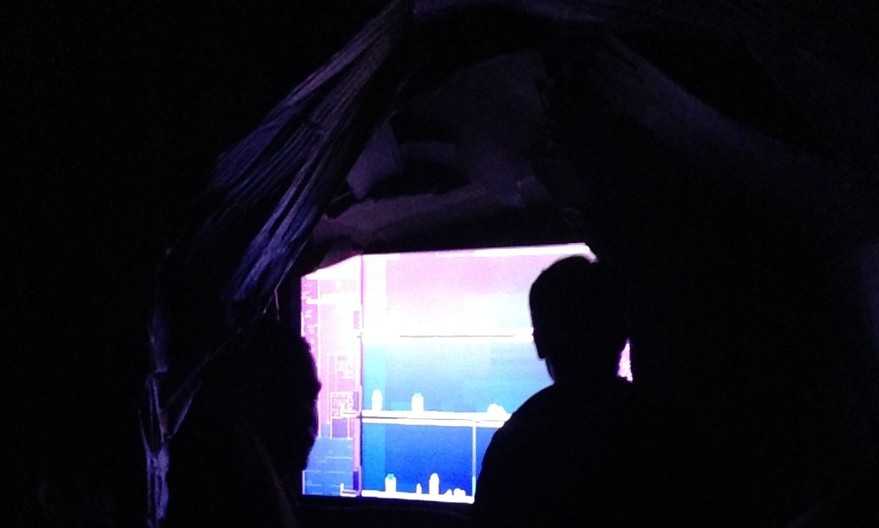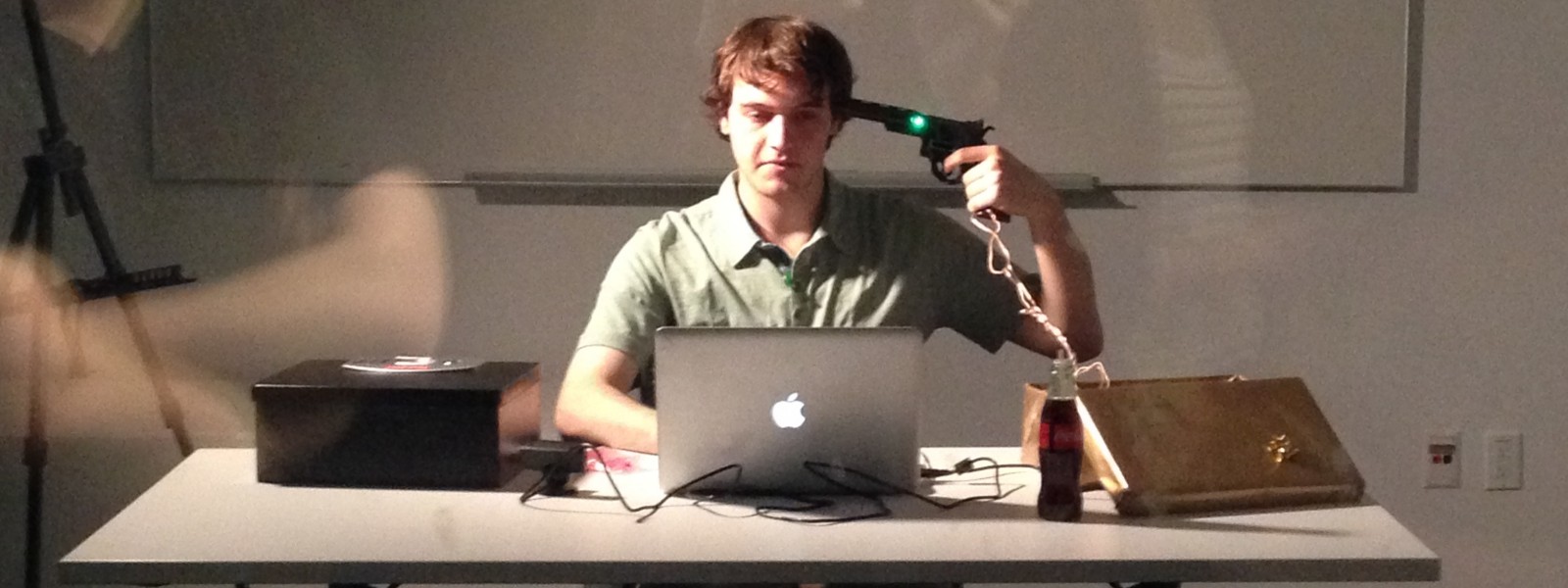A lot can happen in two years. In 2012, NYU’s Game Center program launched its Master of Fine Arts (MFA) program, cementing its place where previously only an undergraduate minor in game design was offered. The Game Center now also occupies the entire 8th floor of 2 Metrotech Center in Brooklyn, New York and just propelled its debut class of MFA graduates into the “real world” a couple weeks back. To celebrate, NYU Game Center hosted a year-end student showcase—an open house exhibition featuring the MFA grads and their projects, among some 30 other playable student works. Now, I’ve attended my fair share of MFA thesis art shows (even exhibited in one myself), but this was my first MFA games exhibition. Not that they don’t have their similarities. What stood out most distinctly at the showcase was the push to cultivate localized communities around games. The MFA projects pursued this goal through catered gaming experiences intended for small audiences, supported by a collaborative academic environment with an inclusive mission.
The showcase took place in the Game Center’s ever-modular Brooklyn space, a labyrinthine work/study area of false walls, wheeled tables, and projectable surfaces. While about half of the MFA projects were videogames displayed on screens meant to be played with traditional controllers, the others were tabletop games, augmented reality tablet games, games with unconventional interfaces, and game-centric conferences. This diversity of projects showed that the Game Center isn’t content with just providing a Masters degree program for games as a part of an interdisciplinary art school, but they’re also including theory, criticism, and curation as potential tracks of study. While these related fields are always intertwined with artmaking, typically they’re broken out into separate programs (think Studio Art and Art History). But here, conferences focusing on community organization and games studies academic papers coexist with management simulators and space shooters in the same degree category. That NYU Game Center is open to this kind of diversity sets an interesting precedent for other colleges and universities as game MFA programs gain more traction nationwide.

The showcase provided grads with a unique opportunity to not only see their games in the hands of novices, but also to install their work in distinct ways that provided environmental ambience. The videogame industry thrives on standardization (controllers, consoles, marketplaces), which allows for more games to come to players instead of players coming to games. However, this convenience has its drawbacks and rarely allows for unique localized experiences. At the Game Center student showcase I played games in a variety of one-off, nonstandard settings, including an office that had been converted into a darkened cave, a Japanese teahouse, a conference room as starship battlestation, and a tween bedroom complete with taped-up images of young heartthrobs pulled out of magazines. To top it off, in one game you’re closed in an office that’s been turned into an interrogation room while onlookers gawk through a window as if it was a two-way mirror—not exactly a readymade Gamestop kiosk.
As someone who’s used to MFA art shows full of largely passive media, I hadn’t realized how much more time a games show takes to experience. It took me a full 3 hours in the show to see all of the MFA projects. Many games only allow for one player at a time or require a commitment beyond 5 minutes to really get a feel for what’s happening, so obtaining a robust understanding of every project on display was not possible. Thus, sadly, I don’t have a firsthand account of Lie to the Devil, the game in the aforementioned interrogation chamber where a computer bargains with you to play Russian roulette with a prop revolver; the queue was hours-long. The showcase as a whole was a half art show, half test-drive sort of event where I could glean certain notions about a work secondhand, but couldn’t really get the complete picture without getting behind each wheel myself.
The game Palimpsest was displayed in a spacious, dark corridor, via projection screen, with its own singular seat, and Xbox controller. While I could easily imagine playing Palimpsest at home on my computer or on my phone while riding the subway, it benefitted from the showcase installation in a few notable ways. The game is an active text adventure where you control a robot, represented as a simple dash, with limited sensory capacities on a remote outpost. With each action, a line of descriptive text also pops in and lingers for a minute above where the action took place. Because the background of Palimpsest is solid black, meant to show the robot’s limited sensory abilities, the edges of the frame bled into the darkened wall on which it was projected. The result was a repetition of the visual theme of the game within the play experience itself; I know there’s a whole big space around me, but i’m only paying attention to this little glowing dash. It’s a wonderful exercise in minimalism and sensory abstraction with a satisfying, if brief and kind of depressing narrative to boot.

Installed in the next room over in a fish tank-like classroom was Asterisk, a 3-vs-3 spaceship battle game. In Asterisk, team members must verbally communicate to delegate tasks between piloting, firing, and repairing their spacecraft, in service of destroying the opposing ship. The room where I played Asterisk was physically divided between the two teams, facing one another on opposite sides of the conference room table, each player operating their own computer. The sensation of playing the game was like something out of a Star Trek episode, crewmembers at various stations shouting things like “They’re coming in on the left!” and “Help, I’m under heavy fire over here!” While Asterisk could technologically be possible in a purely online, remote environment, the localized installation amplified the comradely spirit of the game. High-fives were exchanged.
As I mentioned earlier, not all of the Game Center MFA thesis projects were games; a couple were game-centric community events. Toni Pizza co-organized this year’s Different Games Conference and the Lost Levels “unconference,” both of which use games as a jumping off point for the discussion of broader sociological issues while also providing platforms for individual expression. Despite only being present at the showcase through documentation and Pizza’s friendly, in-person advocacy, the conferences clearly represented sincere, grassroots efforts to concretize what a “gaming community” can be and how to make it a welcoming place for everyone. For a hobby that is often experienced in physical or mental solitude, IRL gatherings like Different Games, Lost Levels, and even the NYU student showcase can be validating and enlightening.
After a couple hours with interactive installation art, I was actually quite taken in coming upon the bare bones, game-y presentation of Over Easy –just a computer monitor on a desk in a well-lit area with an Xbox controller tethered to it. Over Easy is likewise a very straightforward, mechanical game where you have to control two concentric circles without letting their edges touch. The game actually has a lot in common with iOS sensation Hundreds in visual design and in your need to split attention between your left and right thumbs (one for each circle). In a public setting, a game like Over Easy becomes a high-score competition, with onlookers eager to try and unseat previous challengers, harkening back to local arcade scenes of yore. Playing Over Easy at home, alone, without peer pressure, would strip the game of a lot of its appeal; it begs to be played in a crowd.

These weren’t all of the projects on display at the showcase, just a sampling from those that I actually had time to check out. After speaking with Frank Lantz, Director of the NYU Game Center, it sounds like more game design MFA programs are likely to begin cropping up across the US. The NYU event may have only been my first MFA games exhibition, but it’s reassuring and exciting to know that it probably won’t be my last. Increased infrastructure in support of localized game communities would certainly be a good thing, especially if newcomers carry the same inclusive, interdisciplinary spirit that pervaded the Game Center showcase. Not every game is the best fit for the global marketplace, and it’s reassuring to know that there are programs out there trying to make room for all kinds of game makers. I may not have gotten a chance to point a Zapper at my head in Lie to the Devil, but the overflowing queue for it and other oddballs like it certainly indicates that they’re onto something.
